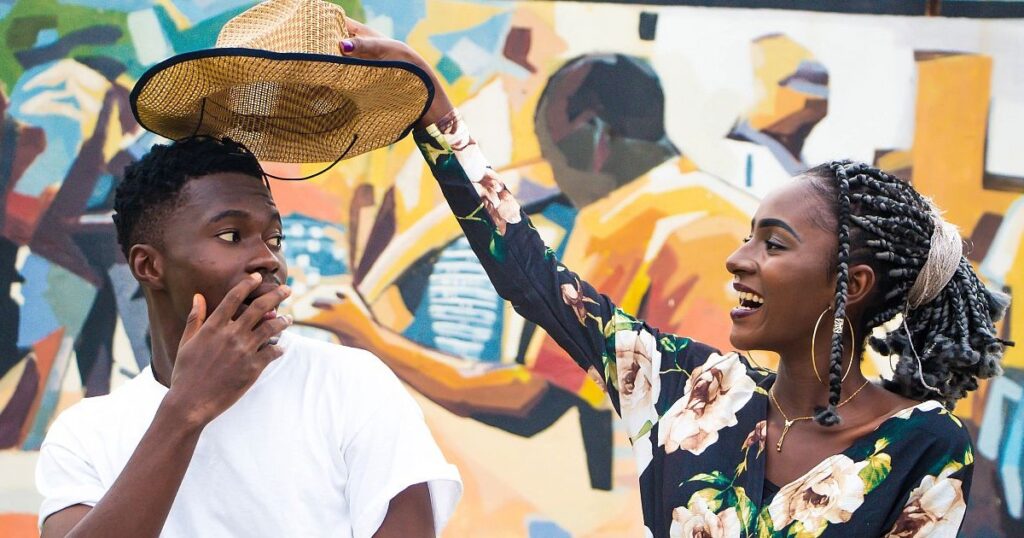HATS OFF TO YOU!
The Hat game played for spontaneity

I was on the evil Facebook a couple of weeks ago and read a comment about The”Hat Game” from Avish Parashar. He was asking about The Hat Game:
“(the one where you try to grab a hat off your scene partner’s head): I have never performed, been taught, or seen this game performed. I have only read about it in “Impro for Storytellers,” and I don’t quite get the point of it – it seems very gimmicky (are you supposed to justify why you are trying to remove the other person’s hat?). Johnstone seems to love it but I thought for the most part he doesn’t like gimmicky stuff, so I am curious if I am missing something here?
I absolutely love the Hat Game.
Unfortunately, It’s one of those exercises that can be taught poorly and misunderstood easily. Many groups I meet for the first time have a similar attitude about the exercise that you feel.
But…
Played as Keith intended, The Hat Game is a great exercise for being present with your partner.
If you and I are in a scene (not with the hats) you may notice moments when I’m in my head planning my “great idea” on how to move the scene forward or on the funny thing I will say next or beating myself up about what I just did. Whatever I’m doing in my head, I’m not being present with you, my scene partner.
So let’s put those hats on.
If you see that I’m not HERE AND NOW in this moment with you. Take my hat off. That’s my reminder to be with you. If I am present with you, there’s little chance you will be able to grab my hat.
That’s the basic premise.
Keith would talk about Buddhist Monks rolling around on the ground in laughter playing this exercise because it connected on many levels for them with being present versus being distracted by ones own thoughts.
A process for teaching.
Begin without hats.
I like to play the initial exercise that Keith talks about called GASKILL’S SAMURAI – See Impro for Storytellers (page 161) for who William Gaskill was and more details.
Basically, you and I stand face to face (no hat). With our hands to our sides and standing within comfortable reach of each other, your job is to reach up and touch my shoulder. My job is to step back or move my shoulder away if I see you trying to do that. We watch each other’s intentions and we respond.
NOTICE – WE ARE PLAYING EACH OTHER. This is important when we move to the hats.
Then, I have a go at it. I shouldn’t be just swinging my arms wildly trying to beat you. It should be precise and I should do it when I am sure I can get you. I’m looking for those moments when you aren’t really with me.
Now, Let’s do it at the same time.
For people who are just throwing their arms wildly, I make a further game and say you each have only 5 shots to touch your partner’s shoulder. See who can get the most hits with those attempts. (You can see that it isn’t about the competition. That added rule – IF NEEDED – is thrown in to make players attend to what’s really going on with each other and not to focus on WINNING.)
PART TWO
Safety first – Keith would do many rounds of practice in the mechanics of taking a hat off your partner. I have a hat on. You don’t. We face each other standing close enough that I can easily reach your hat without leaning in.
We aren’t playing the game. I allow you to reach UP, AND OVER THE TOP to grab my hat. We do that a few times to train the body to grab the hat safely. Many competitive people grab by throwing their hand straight into the face of their partner recklessly. They can (and have) injured their partners with thumbs in the eyes and smacks to the side of the head.
Now that you’ve trained yourself a little, I get to do the same. Grabbing for the top of the hat which is dented in so I don’t inadvertently grab a clump of your hair.
Let’s play…
 Many people will play competitively safe, standing far away and keeping their hands close to their own hat protectively trying to maximize their chance of winning.
Many people will play competitively safe, standing far away and keeping their hands close to their own hat protectively trying to maximize their chance of winning.
These people are PLAYING THE HAT. Remember what I mentioned earlier? PLAY YOUR PARTNER. Take a healthy risk and play this like Gaskill’s Samurai earlier. Put your hands by your sides and stand closer. Or, as Keith says, “RISK THE HAT GUYS!”
If the players are constantly keeping their distance and lowering all risks and tension, bring out the sofa or a couple of chairs. (The sofa is nice because the armrests on the side are a barrier against moving away and the middle is open with your partner.) Have the players sit on the sofa.
Now try the Hat game where players must stay seated.
People who leap to grab the hat right away usually fail because their partner sees them coming and they can take the hat out of play (moving away, putting their hand on the hat.). Again we want this to be elegant. If you know your partner won’t allow you to take the hat because they are present and aware of your intentions, then don’t take the hat. Watch them. When they disconnect and are in their thoughts TAKE THE HAT!
 Some people are so disconnected that they lose their hat to the slowest partners. I love the moment when one player’s hand moves in slow motion and can take the other players hat. This should never happen, BUT people can be so unaware that it DOES happen. A lot.
Some people are so disconnected that they lose their hat to the slowest partners. I love the moment when one player’s hand moves in slow motion and can take the other players hat. This should never happen, BUT people can be so unaware that it DOES happen. A lot.
You aren’t just trying to grab a hat. You are training your partner to be present on stage.
I’ve never heard Keith call this a filler game. This is one of the best training exercises AND it elicits some of the finest moments in connection between partners.
I’ve seen the beginnings of great scenes from the hat game. Unfortunately, in shows, the scene ends when there’s an attempt to take the hat. (You lose if your hat is taken OR if you attempt to take your partner’s hat and fail.)
In one variation when you remove your partner’s hat, you whack with it, give it back and continue the scene OR if your partner tries to take your hat and missed, you take your own hat, hit them with it, put it back on your head and continue the scene.
But, as the primary purpose of the Hat Game isn’t necessarily narrative (even though being present with each other is doing a lot to help our storytelling), we can sacrifice a few potential scenes for the joy that this game brings to players and audience when it’s played right. And HOPEFULLY we can learn a lot and take the lesson forward into actual scene work.
Learn to be present and PLAY WITH EACH OTHER – not just ‘playing by ourselves and our own “great” ideas, while we ignore what offers our partner is making.
FOLLOW UP EXERCISE:
Do a scene. Without hats, If your partner isn’t with you (in their head thinking about their next move) click your fingers. Your partner leaves the stage and is replace by someone else (who hopefully will be WITH you). They are going to do the same to you so be WITH them.
I assure you, if played right, the Hat Game is one of the best exercises and most enjoyable moments you will have on stage.
Side note… Blidnfolded hat games and Blindfolded hat games with mousetraps in bare feet ARE filler games… but… they can be fun variation when you get the actual game right.




0 Comments